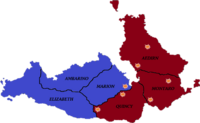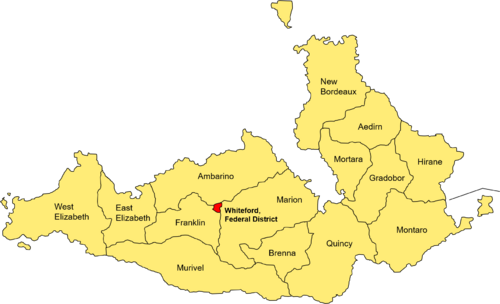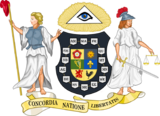Amrelia
Amrelian Federative Republic | |
|---|---|
Motto: Concordia, Natione, Libertatis (Latin) "Unity, Nation, Liberty" | |
Anthem: O My Amrelia, Land of Liberty | |
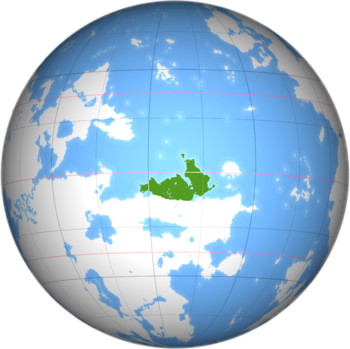 Location of Amrelia (dark green) in Thrismari | |
| Capital | Whiteford, Federal District |
| Largest city | Willington |
| Official languages | None at the federal level (de jure) English (de facto) |
| Recognised national languages | French, German, Italian, Spanish |
| Ethnic groups (2019) | 89% White 5% Asian 3% Black 3% other |
| Religion (2019) | 83.3% Christianity —64.6% Roman Catholicism —18.7% Protestantism 12.4% No religion 3.7% Islam 0.6% Others |
| Demonym(s) | Amrelian |
| Government | Federal multi-party assembly-independent directorial republic |
| Frederic Carrington, FED (First Consul) Adrian Lord, FED (Vice Consul) Retha Wright, REP Ezra Weston, LIB | |
• President of the Chamber of Deputies | Ephraim Gale, FED |
• Chief Justice | Virginia Switzer |
| Legislature | Federal Assembly of the Union |
| Senate | |
| Chamber of Deputies | |
| Formation | |
• Unification | February 8, 1654 |
• Republic established | August 1, 1780 |
• Federal state | November 2, 1790 |
• Current Constitution | May 16, 2001 |
| Area | |
• Total | 1,208,249 km2 (466,508 sq mi) |
| Population | |
• 2019 estimate | 75,721,796 |
• Density | 62.4/km2 (161.6/sq mi) |
| GDP (nominal) | 2019 estimate |
• Total | $2.551 trillion |
• Per capita | $45,168 |
| HDI (2019) | 0.900 very high |
| Currency | Scudo (₴) (SCU) |
| Time zone | UTC0, +1 (UTC) |
| Date format | mm/dd/yyyy |
| Driving side | right |
| Calling code | +11 |
| Internet TLD | .ar, .afr |
Amrelia, officially the Amrelian Federative Republic (commonly abbreviated AFR), and known more simply as just the Federative Republic or the Federation, is a sovereign state in northeastern Thrismari. Amrelia is composed of 14 federated states and a federal district, Whiteford, which serves as the capital. Willington is the largest city. It has short land borders with Diegistan to the southwest and Norkantion to the southeast with the Sunadic Ocean to the north, east, and west. Spanning two time zones, the AFR occupies an area of 466,507 sq mi (1,208,249 km²) and has a population of over 75 million people, making it the 17th-most populous country. There is no official language at the federal level, however English is the most commonly spoken language. Other recognized languages include French, German, Italian and Spanish.
HISTORY
Amrelia is a federal directorial multi-party republic ruled by the four member Federal Directory, with the position of First Consul and Vice Consul rotating each year. Legislative authority is vested in the bicameral Federal Assembly; the Senate consists of 43 members, 3 Senators per state and 1 for the Federal District, and the Chamber of Deputies, which consists of 339 members elected by a first-past-the-post system. Major urban areas of the nation include Willington, Annesburg, Toussaint, and Lakengren. The country is multi-ethnic and multi-cultural. Roman Catholicism is the majority and official religion, however the constitution grants freedom of religion to all citizens.
The Federative Republic is a highly developed country with a large economy. It maintains close relations with several countries and is a member of the International Court, Anterian World Assembly and a member of the Thrismari Union.
Etymology
Etymology
History
Amrelia has existed as a state in its present form since it became a federal republic in 1790 and adopted a constitution which is still in use today. The precursors of Amrelia established a protective alliance at the beginning of the 14th century, forming a loose confederation of states which persisted for centuries.
Early history
Evidence of modern human habitation in the land known as Amrelia today dates back 20,000 years. The earliest known cultural tribes of the area were members of the Lindow and Caerdydd cultures. These cultures developed and flourished during the Late Iron Age from around 500 BC. One of the most important tribal groups in the region was the Amrelii. Wishing to abandon their homes around the O'Creagh Lakes and migrate north, they were eventually defeated by a combined force of the other tribes, forcing the Amrelii to return.
Confederacy
The Confederacy was an alliance among the several regional states that inhabited Amrelia. Effectively governed by Princes of various states, which were de facto monarchs in control of trade and administration, the Confederacy facilitated management of common interests and ensured peace in the valleys and mountain passes. The official founding document of the Confederacy is dated to the year 1305, when the western states of Elizabeth, Franklin, Ambarino, Marion, Murivel, and Quincy agreed to establish an alliance of joint defense as well as remain united on judicial matters. The eastern states of New Bordeaux, Aedirn, Hirane, and Montaro did not sign the document, but would in the coming decades join the united Confederacy. This expansion led to increased power and wealth for the confederation.
*some info*
The Confederacy expanded and gained much reputation with neighboring states. By the mid 16th century, the Confederates controlled land as far west and east as the Sunadic Ocean, south as the Glyswen Mountains, and north as the wetlands of Varoux. Setback occurred, however, in 1590, with the Confederate defeat in the *war name*. This is generally considered to be the beginning of the decline of the loosely-united Confederacy. Combined with the worsening Amrelian economy, inter-state religious conflicts, and growing authoritarianism of the ruling princes and families, the situation in the lands were ripe for civil war.
In 1615, Amrelian traders that had set off from the port town of Sanford in eastern Amrelia some years prior discovered and settled modern day Layfet as a colony on the continent of Meredonne.
Amrelian Civil War and unification
The birth of the Kingdom of Amrelia was the result of efforts by Amrelian nationalists and monarchists loyal to the House of Bohannon aiming to establish one unified kingdom composed of all the states in the confederacy. Not only the upper classes and nobility, but also ordinary Amrelians had grown increasingly tired and frustrated with the Confederacy, which was able to maintain order and prosper for more than three centuries but now slowly crumbling into chaos. For more than sixty years civil strife, inequality and economical depression plagued the lands.
During this time, seeing that devolution would bring about the end of their lands, several ruling princes in the Confederacy sought to convene and elect a single ruler which would finally unite Amrelians under a single flag. Not every prince held this view, however. In the summer of 1649, the ruling princes of six states (Elizabeth, Franklin, Ambarino, Marion, Murivel, and Quincy) made a joint declaration requesting that all the princes meet in Marion's capital of Willington to address the crisis unfolding in the confederation. Marion was largely considered the most powerful state thanks to its access to the Gulf of Lannahechee, population and production, making its prince the most likely choice of becoming monarch. The princes of New Bordeaux, Aedirn, Hirane, and Montaro denied the invitation and did not send delegations. Following the Council of Willington, the six princes and their courts unanimously declared that Marion's ruler, Lemuel Bohannon (now styled Ammiras I), was the first monarch under the new Kingdom of Amrelia, and pledged to him full loyalty; the lands of these princes now forming into one nation. When the princes of the eastern states heard of this, they subsequently met with each other and declared war on the kingdom, stating that they would not be forced to unify and would fight for the survival of the Confederacy.
During the fall and winter of 1649, the Kingdom and Confederacy quickly raised volunteer and conscription armies that fought mostly in the east for five years. The King's forces, though suffering a few defeats, ultimately proved superior against the loosely organized but stubborn Confederates. It is believed that around 580,000 Amrelian soldiers and civilians died in the war, making it the deadliest military conflict in Amrelian history. The war ended on February 8, 1654, when the last major Confederate army under General Edward Vansant surrendered to Ammiras I's forces while besieging Aedirn's capital, Ballants. The war proved tragic for the eastern states' land, and a long period of reconstruction began with all of Amrelia now unified under a central government.
Monarchical period
monarchy yay
Revolutionary Amrelia
revs
Federal state
the feds
Modern history
Amrelia managed to stay neutral during the Great War, the first and largest global conflict, which took place from 1905 to 1911. Shortly after conflict began in Thrismari in the spring of 1906, the Federal Directory proclaimed a policy of neutrality, however many members of both the Directory and Federal Assembly had sympathies with the Alliance members and the Kingdom of Blechingia in particular. In July of 1906 as the fighting in southern Thrismari increased, First Consul Constantine Perkins issued a proclamation that called for more men to join the ranks of the Army, and the Amrelian Navy, although small at that time, increased its patrols, despite the fact that the war was happening far to the south and Amrelia had no immediate threat. Still, there were several times during the conflict that Amrelian leaders looked to join the Alliance powers. As a result of the proclamation, the Army increased from about 25,000 men to over 80,000; many of these troops were stationed along the southern border in the state of Murivel, patrolling the many Glyswen Mountain passes, however troops were also stationed in major port cities.
While public sentiment rose in favor of the Alliance as the war dragged on to 1908 and following the use of mustard gas and chemical weapons, the majority of Amrelians favored remaining neutral. Leaders of most religious groups were pacifists in the nation, especially those of the Catholic Church, which had a major presence in Amrelia during the Great War and still does to this day. Not only that, but many Amrelians saw it pointless to become involved in a deadly war happening so far away from home, albeit still within the Thrismari continent. Neutrality came into question during the 1908 federal elections, which was dominated by the ongoing war; the Federalist-Republicans and other anti-war parties remained popular. Amrelian leaders resolved to only engage in the war once Amrelian shipping and trade became severely threatened, which almost happened on several occasions.
As the war began to die down in Thrismari in early 1909, the number of troops deployed began to drop back to normal pre-war levels and a greater emphasis was placed on naval power to defend shipping in the Sunadic Ocean.
~other history~
The Federative Republic joined the Anterian World Assembly and International Court in 2020. In February 2021 it joined the Thrismari Union, an organization focused on human rights, international stability and free travel through the nations of the Thrismari continent. The Federative Republic is also apart of a defensive pact within the Union.
Geography
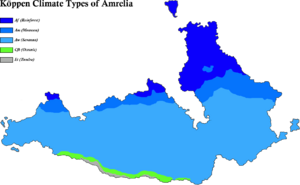
Amrelia is located in northeastern Thrismari. The 14 states and Federal District occupy an area of 466,508 sq mi (1,208,249 km2), making it the # largest in the world. It has short land borders with Diegistan to the southwest and Norkantion to the southeast. To the direct south at the border lies the large Glyswen Mountain Range, beyond that is uncharted land. To the north, east, and west is the Sunadic Ocean, where Amrelia shares maritime boundaries with Myclea.
Amrelia lies within the equatorial region and presents five natural regions depending on the temperature, humidity, winds, rainfall, and altitude. These are tropical rainforests, savannas, and mountain climate, though the latter is only present in the far southern parts of the country near the Glyswen Mountains. Tropical storms frequently effect the northern parts of the country. Temperatures along the equator are high, averaging above 77 °F (25 °C). There is little seasonal variation near the equator, although at times it can get cool enough for wearing a jacket, especially in the rain. Generally, the further south you travel, the more hilly and mountainous it becomes.
Biodiversity
Amrelia is a medgadiverse country with a high number of species. There are over 200 mammal species and 500 species of birds. 230 reptile species have been recorded in the country, including about 130 species of snakes and 60 species of lizards. There are also about 100 species of frogs and thousands of insect species. Thousands of species of fungi have been recorded in the country.
Larger mammals include carnivores such as pumas, jaguars, ocelots, rare bush dogs, and foxes, and herbivores peccaries, tapirs, anteaters, sloths, opossums, and armadillos. Deer are plentiful in the southwest, and many species of New World monkeys are found in the northern rain forests.
Environment
env
Government and politics
Amrelia is a federal directorial multi-party republic of 14 states and a Federal District where the capital city of Whiteford is located. It has been a federation since the Second Republic was dissolved in 1790.
In the Amrelian federalist system, citizens are subjected to federal, state, and local governments. The government also has a system of checks-and-balances laid out in the Federal Constitution, which is the most important codified form of law in the nation. It sets out the foundation and boundaries of the federal government as well as basic civil liberties. Proclaimed to the public on November 2, 1790, it formed an indissoluble union of 14 states and the Federal District. It has since been amended several times. Each state has their own constitution is structured in roughly the same fashion as the federal government.
The federal government comprises of three branches:
- Executive: Executive authority is vested in a collegial body of four members called the Federal Directory, which are elected for a four year term by the Federal Assembly with the position of Consul and Vice Consul rotating among the members each year. The Consul chairs the federal government and possesses representative functions. The Directory controls the federal administration and serves as a collective Head of State, and each member traditionally chairs one of the four major federal administrative departments (i.e. the Department of Infrastructure or Department of Defense).
- Legislative: Federal legislative power is vested in the bicameral Federal Assembly of the Union which makes federal law, declares war, approves treaties, has the power of the purse, and has the power of impeachment, by which it can remove sitting members of the government. It is comprised of an upper house, the Senate, and a lower house, the Chamber of Deputies. Members from both houses are elected by first-past-the-post.
- Judicial: The judicial system of Amrelia comprises three types of courts: orindary courts, which deal with criminal and most civil cases, the specialized courts which hear cases related to administrative, labor, social, fiscal, and patent law, and finally constitutional courts which focus on judicial review and constitutional interpretation. The highest of these courts is the Supreme Federal Court of Justice (or just Supreme Court) which has 11 justices and can overturn laws they find unconstitutional.
The Senate represents the individual states in the Union and consists of 43 members. Each state gets 3 Senators while the Federal District only receives 1. Meanwhile, the Chamber of Deputies is comprised of 339 members each representing an electoral district: one district per 250,000 people and at least 7 Deputies per state. All Senators and Deputies are up for election every four years.
Law
As Amrelia is a federal nation, it has federal, state, and local laws. Many states have laws that are not found in other states or at the federal level. States have legal rights to nullify or invalidate any federal law they deem unconstitutional with respect to the Federal Constitution. Also, all laws and governmental procedures are subject to judicial review and any law ruled by the courts to be in violation of the Constitution is voided.
Political divisions
Amrelia comprises 14 federal states which are the principal administrative divisions in the country. These are subdivided into counties and further divided into municipalities. The Federal District contains the capital, Whiteford. The states have a permanent constitutional status and, in comparison with the situation in other countries, a high degree of independence. Under the Federal Constitution, all states are equal in status. Each state has its own constitution as well as its own legislature, government, police and courts.
Citizenship is granted at birth in all states and the Federal District.
| Flag | State | Capital | Population | Area |
|---|---|---|---|---|
| Marion | Willington | 16,542,228 | Example | |
| Ambarino | Rio Bravo | 14,215,654 | Example | |
| Franklin | Cholla Springs | 12,069,223 | Example | |
| Gradobor | Lakengren | 7,644,826 | Example | |
| Quincy | Owanjila | 6,076,744 | Example | |
| New Bordeaux | Toussaint | 6,000,444 | Example | |
| Mortara | Epping | 4,511,208 | Example | |
| Aedirn | Rose Valley | 3,133,487 | Example | |
| Montaro | Elmswood | 2,874,211 | Example | |
| Brenna | Walden | 2,853,025 | Example | |
| Hirane | Coliheim | 2,009,373 | Example | |
| West Elizabeth | Wimborne | 1,600,179 | Example | |
| East Elizabeth | Lyria | 909,509 | Example | |
| Murivel | O'Creagh's Run | 782,005 | Example | |
| Federal District | Whiteford | 500,124 | Example |
Foreign relations
Amrelia a member of just a few international organizations. It joined the Anterian World Assembly and International Court in 2020, having a judge as one of the seven justices of the Court.
In February 2021 Amrelia joined the Thrismari Union, an organization focused on human rights, international stability and free travel through the nations of the Thrismari continent. The Federative Republic is also apart of a defensive pact within the Union. It is the the # largest nation in the Union by population and # largest by area.
Amrelia maintains close relations with several countries.
Amrelia strongly supports multilateral international politics, endorsing the World Assembly and its activities. As of February 2021 Amrelia currently has no foreign troop deployments, though it is committed to humanitarian peacekeeping efforts when such need arises and maintains military units ready to deploy to regional crises in a moment's notice.
Military
The Armed Forces of the Amrelian Federative Republic consist of four official branches: the Army, Amrelia's land warfare branch; the Navy, a blue-water navy with a fleet of 113 commissioned ships, together with the Marine Corps, a highly specialized amphibious light infantry force; the Air Force, a technologically sophisticated air force with a diverse operational fleet consisting of both fixed-wing and rotary aircraft; and the Coast Guard, which operates as coastal defense, search and rescue, and maritime law enforcement. The military is led by the Chief of the Armed Forces, who then reports to the Department of Defense and Federal Directory. The Armed Forces are charged with protecting the Amrelian homeland, promoting its global security interests and supporting international peacekeeping efforts.
The military is completely voluntary, although there are provisions in the Constitution that permits the Federal Assembly to impose conscription ages 18-45 during wartime. As of 2019, there are a total of 663,054 personnel in the Armed Forces, of which 178,416 are active. These numbers do not count the National Guard, which has roughly 75,000 total personnel. Broken down, the Army consists of 410,515 (75,000 active), the Air Force 90,427 (29,654 active), the Navy 125,888 (50,655 active), the Marine Corps 21,224 (11,010 active), and the Coast Guard 15,000 (12,097 active).
Amrelia spends approximately 2.3% of its GDP on its military. ~spending explained~
~gun politics~


